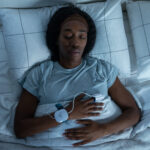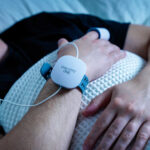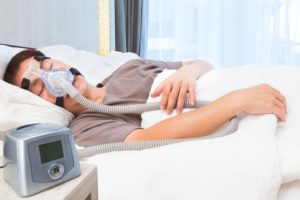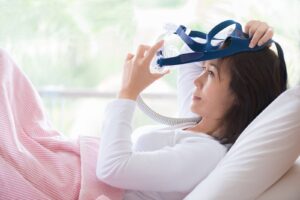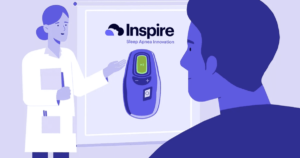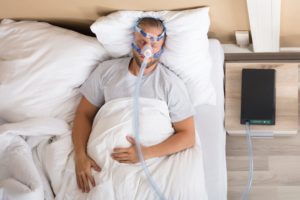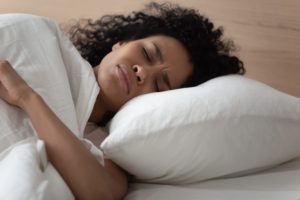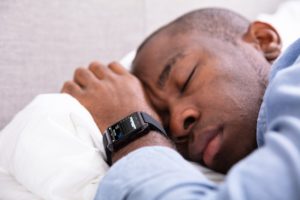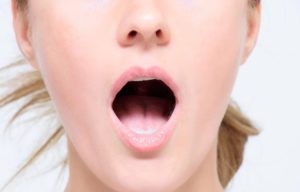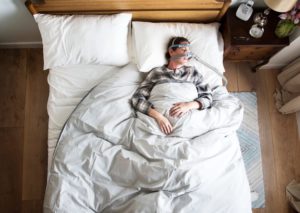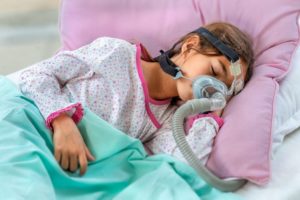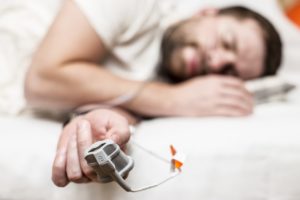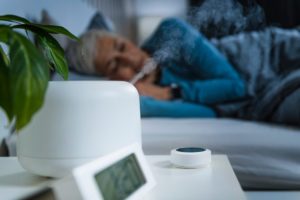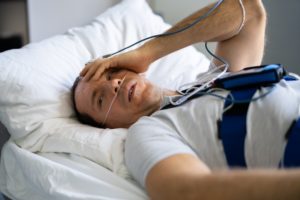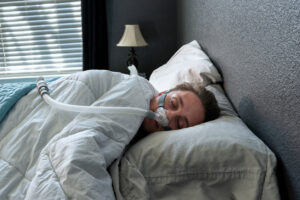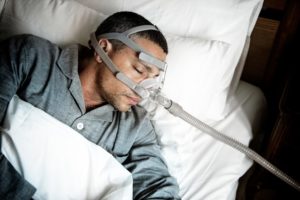When you buy through our links, we may earn a commission. Products or services may be offered by an affiliated entity. Learn more.
STOP-Bang Score for Obstructive Sleep Apnea
Obstructive sleep apnea (OSA) is a sleep disorder in which the airway is partially or completely blocked multiple times during the night, interfering with breathing. As it causes repetitive disruptions in breathing and sleep, OSA has been linked to a higher risk of heart attacks, diabetes, and other serious conditions, as well as ongoing tiredness.
The number of people with OSA is increasing, but many people do not realize they have the disorder, because symptoms primarily appear during sleep. Some researchers estimate that moderate to severe OSA may go undiagnosed and untreated in 80% of people with the condition. To identify people who may benefit from obstructive sleep apnea testing, researchers have developed a simple eight-question survey called the STOP-Bang Questionnaire.
What Is the STOP-Bang Questionnaire?
The STOP-Bang Questionnaire is intended to give physicians an easy-to-use tool to identify people who might have obstructive sleep apnea. The questionnaire consists of eight yes-or-no questions based on the major risk factors for OSA. The name STOP-Bang is an acronym for the first letter of each symptom or physical attribute often associated with OSA:
- Snoring: This question assesses whether or not you snore loudly enough to bother a bed partner.
- Tiredness: This symptom involves feeling daytime tiredness, which may include falling asleep during daily tasks.
- Observed Apnea: If a sleep partner has noticed that you stop breathing or gasp for air as you sleep, this can be a sign of OSA.
- Pressure: High blood pressure is also a symptom.
- BMI: Physicians look for a body mass index that is higher than 35.
- Age: Those who are older than 50 are at higher risk for OSA.
- Neck Circumference: Physicians measure your neck circumference. A measurement greater than 16 inches is considered a risk factor.
- Gender: Males are considered to be more likely to have OSA.
Think You May Have Sleep Apnea? Try an At-Home Test
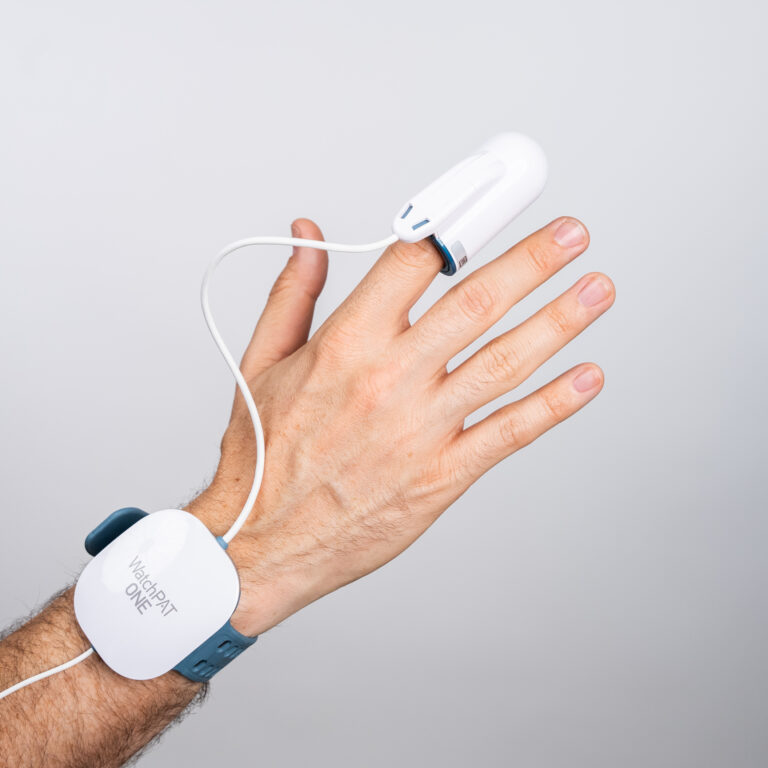
our partner at sleepdoctor.com
10% off Home Sleep Tests
Buy Now“Truly grateful for this home sleep test. Fair pricing and improved my sleep!”
Dawn G. – Verified Tester
What Do STOP-Bang Scores Mean?
When filling out the STOP-Bang questionnaire, a person receives one point for each symptom or risk factor, for a maximum of eight points. In general, the higher a person scores on the questionnaire, the greater risk they face of having moderate or severe OSA. Studies have also found that higher STOP-Bang scores are associated with more severe OSA .
A STOP-Bang score of 2 or less is considered low risk, and a score of 5 or more is high risk for having either moderate or severe OSA. For people who score 3 or 4, doctors may need to perform further assessment to determine how likely they are to have OSA.
When Is the STOP-Bang Test Used?
Doctors often use the STOP-Bang Questionnaire when they suspect a patient they are seeing might be at risk of having OSA. The STOP-Bang test can help doctors decide which people to prioritize for polysomnography, the sleep study used to diagnose OSA. First developed to screen for OSA in people about to undergo elective surgery , the STOP-Bang Questionnaire has since been used for a wide variety of people and is considered an acceptable screening tool when used in sleep clinics or the general public.
Screening for OSA is important in a surgical context, because people with OSA have a higher risk of complications. For this reason, it is important that anesthesiologists and medical staff know if a person about to undergo surgery has undiagnosed OSA, so they can provide additional care. An estimated 70% of people who undergo weight loss surgery have OSA. The STOP-Bang Questionnaire can identify people who need extra attention during and after surgery, so staff minimize the risks posed by surgery, anesthetic agents, and medications prescribed after surgery.
Is the STOP-Bang Questionnaire a Reliable Tool to Diagnose Obstructive Sleep Apnea?
STOP-Bang is an effective tool for assessing specific risk factors and ruling out OSA. Those who have more risk factors should be further evaluated.
Independent researchers have found the STOP-Bang Questionnaire useful as a screen for OSA in adults with Down syndrome , people with type 2 diabetes , pregnant people with obesity , and adults over 40 . Findings from Brazilian and Swedish studies suggest that the questionnaire may be highly accurate for predicting OSA in people who receive specific scores, but less accurate for other scores.
In an analysis of over 100 research studies, researchers found that the STOP-Bang questionnaire could more accurately predict who has mild, moderate, and severe OSA than three other questionnaire tools. The test may have a high rate for false positives, however, leading to unnecessary healthcare costs if doctors send too many patients for sleep tests based on the STOP-Bang results. The accuracy of the test may vary depending on characteristics of the people taking it and whether they have any other conditions.
The STOP-Bang Questionnaire performs less well for certain groups of people, such as veterans and those with kidney failure. One of the items on the test, neck circumference, could turn out differently depending on how it is measured, which would also affect scores.
In the interest of keeping the test simple, each item is awarded an equal point, even though some of the risk factors are more significant than others. For example, a person with a high BMI or a thicker neck circumference is more likely to have OSA than someone who is merely older than 50 years. These details explain why the test is not perfect. However, the STOP-Bang test is a useful first step that may indicate whether it is worth conducting a more specific test.
STOP-Bang Adaptations
Researchers have adapted details of the STOP-Bang, so it better screens different groups of people.
For example, a Brazilian study found that a simplified version with a different BMI cutoff point performed well for older adults. Researchers have pointed out that for women, the gender question automatically guarantees a lower score, so at-risk women may need to use a lower threshold when determining their OSA risk. Used together with several other measures, the STOP-Bang score can help predict a second heart-related event in a person who has been admitted to hospital for a heart attack .
Researchers have also experimented with giving more weight to certain questions on the test. For example, under one system, people who score a 3 or a 4 but whose test results reflect a yes for BMI, male gender, or a larger neck circumference would be classed as high-risk.
Can the STOP-Bang Questionnaire Diagnose Other Types of Sleep Apnea?
The STOP-Bang Questionnaire was developed for detection of OSA, and the overwhelming majority of studies have focused on its use for OSA. As opposed to OSA, lapses in breathing during central sleep apnea are due to problems in brain signaling instead of physical obstruction of the airway. Generally, STOP-Bang studies exclude central apneas , or cessations in breathing due to causes other than an obstructed airway, in their analyses. As a result, we do not know how well or if the STOP-Bang Questionnaire is a useful screening for central sleep apnea.
The STOP-Bang Questionnaire is a simple and validated screening tool for OSA. Interpretation and further intervention after a positive score should involve a discussion with an experienced clinician.

Still have questions? Ask our community!
Join our Sleep Care Community — a trusted hub of sleep health professionals, product specialists, and people just like you. Whether you need expert sleep advice for your insomnia or you’re searching for the perfect mattress, we’ve got you covered. Get personalized guidance from the experts who know sleep best.
References
16 Sources
-
Chung, F., Liao, P., & Farney, R. (2015). Correlation between the STOP-Bang score and the severity of obstructive sleep apnea. Anesthesiology, 122(6), 1436–1437.
https://pubmed.ncbi.nlm.nih.gov/25988411/ -
Nagappa, M., Wong, J., Singh, M., Wong, D. T., & Chung, F. (2017). An update on the various practical applications of the STOP-Bang questionnaire in anesthesia, surgery, and perioperative medicine. Current Opinion in Anaesthesiology, 30(1), 118–125.
https://pubmed.ncbi.nlm.nih.gov/27898430/ -
Fernandez-Bustamante, A., Bartels, K., Clavijo, C., Scott, B. K., Kacmar, R., Bullard, K., Moss, A., Henderson, W., Juarez-Colunga, E., & Jameson, L. (2017). Preoperatively screened obstructive sleep apnea is associated with worse postoperative outcomes than previously diagnosed obstructive sleep apnea. Anesthesia and Analgesia, 125(2), 593–602.
https://pubmed.ncbi.nlm.nih.gov/28682951/ -
De Carvalho, A. A., Amorim, F. F., Santana, L. A., de Almeida, K. J., Santana, A. N., & Neves, F. A. (2020). STOP-Bang questionnaire should be used in all adults with Down Syndrome to screen for moderate to severe obstructive sleep apnea. PLoS One, 15(5), e0232596.
https://pubmed.ncbi.nlm.nih.gov/32384092/ -
Teng, Y., Wang, S., Wang, N., & Muhuyati (2018). STOP-Bang questionnaire screening for obstructive sleep apnea among Chinese patients with type 2 diabetes mellitus. Archives of Medical Science: AMS, 14(5), 971–978.
https://pubmed.ncbi.nlm.nih.gov/30154877/ -
Pearson, F., Batterham, A. M., & Cope, S. (2019). The STOP-Bang questionnaire as a screening tool for obstructive sleep apnea in pregnancy. Journal of Clinical Sleep Medicine: JCSM: Official Publication of the American Academy of Sleep Medicine, 15(5), 705–710.
https://pubmed.ncbi.nlm.nih.gov/31053210/ -
Silva, G. E., Vana, K. D., Goodwin, J. L., Sherrill, D. L., & Quan, S. F. (2011). Identification of patients with sleep disordered breathing: Comparing the four-variable screening tool, STOP, STOP-Bang, and Epworth Sleepiness Scales. Journal of Clinical Sleep Medicine: JCSM: Official Publication of the American Academy of Sleep Medicine, 7(5), 467–472.
https://pubmed.ncbi.nlm.nih.gov/22003341/ -
Neves Junior, J. A., Fernandes, A. P., Tardelli, M. A., Yamashita, A. M., Moura, S. M., Tufik, S., & da Silva, H. C. (2020). Cutoff points in STOP-Bang questionnaire for obstructive sleep apnea. Arquivos de Neuro-Psiquiatria, 78(9), 561–569.
https://pubmed.ncbi.nlm.nih.gov/33053014/ -
Christensson, E., Franklin, K. A., Sahlin, C., Palm, A., Ulfberg, J., Eriksson, L. I., Lindberg, E., Hagel, E., & Jonsson Fagerlund, M. (2018). Can STOP-Bang and pulse oximetry detect and exclude obstructive sleep apnea? Anesthesia and Analgesia, 127(3), 736–743.
https://pubmed.ncbi.nlm.nih.gov/29958223/ -
Chiu, H. Y., Chen, P. Y., Chuang, L. P., Chen, N. H., Tu, Y. K., Hsieh, Y. J., Wang, Y. C., & Guilleminault, C. (2017). Diagnostic accuracy of the Berlin questionnaire, STOP-BANG, STOP, and Epworth sleepiness scale in detecting obstructive sleep apnea: A bivariate meta-analysis. Sleep Medicine Reviews, 36, 57–70.
https://pubmed.ncbi.nlm.nih.gov/27919588/ -
Abumuamar, A. M., Dorian, P., Newman, D., & Shapiro, C. M. (2018). The STOP-BANG questionnaire shows an insufficient specificity for detecting obstructive sleep apnea in patients with atrial fibrillation. Journal of Sleep Research, 27(6), e12702.
https://pubmed.ncbi.nlm.nih.gov/29682848/ -
Martins, E. F., Martinez, D., Cortes, A. L., Nascimento, N., & Brendler, J. (2020). Exploring the STOP-BANG questionnaire for obstructive sleep apnea screening in seniors. Journal of Clinical Sleep Medicine: JCSM: Official Publication of the American Academy of Sleep Medicine, 16(2), 199–206.
https://pubmed.ncbi.nlm.nih.gov/31992408/ -
Orbea, C., Lloyd, R. M., Faubion, S. S., Miller, V. M., Mara, K. C., & Kapoor, E. (2020). Predictive ability and reliability of the STOP-BANG questionnaire in screening for obstructive sleep apnea in midlife women. Maturitas, 135, 1–5.
https://pubmed.ncbi.nlm.nih.gov/32252960/ -
Calvillo-Argüelles, O., Sierra-Fernández, C. R., Padilla-Ibarra, J., Rodriguez-Zanella, H., Balderas-Muñoz, K., Arias-Mendoza, M. A., Martínez-Sánchez, C., Selmen-Chattaj, S., Dominguez-Mendez, B. E., van der Harst, P., & Juarez-Orozco, L. E. (2020). Integrating the STOP-BANG score and clinical data to predict cardiovascular events after infarction: A machine learning study. Chest, 158(4), 1669–1679.
https://pubmed.ncbi.nlm.nih.gov/32343966/ -
A.D.A.M. Medical Encyclopedia. (2019, July 15). Central sleep apnea. MedlinePlus., Retrieved August 29, 2021, from
https://medlineplus.gov/ency/article/003997.htm -
Farney, R. J., Walker, B. S., Farney, R. M., Snow, G. L., & Walker, J. M. (2011). The STOP-Bang equivalent model and prediction of severity of obstructive sleep apnea: Relation to polysomnographic measurements of the apnea/hypopnea index. Journal of Clinical Sleep Medicine: JCSM: Official Publication of the American Academy of Sleep Medicine, 7(5), 459–65B.
https://pubmed.ncbi.nlm.nih.gov/22003340/


